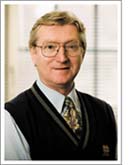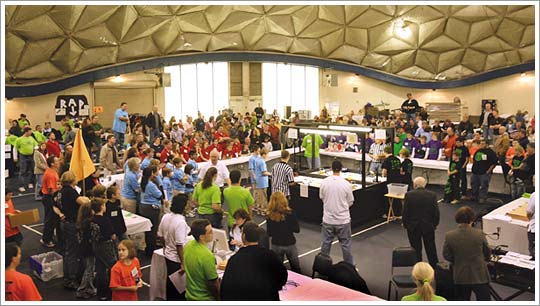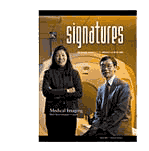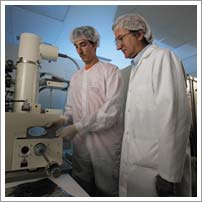Nanotechnology: Shaping
the World Atom by Atom
 Wolfgang
Porod Wolfgang
Porod
Department of Electrical Engineering
The emerging fields of nanoscience and nanoengineering
are leading to unprecedented understanding and control over the fundamental
building blocks of all things physical. This is likely to change
the way many things are designed and manufactured, with tremendous
potential for innovative applications across a vast array of fields
including healthcare, the environment, biotechnology, energy and
food production, information technologies, and aerospace. This momentum
has been building for quite some time.
During a Congressional
hearing in April 1998, the chief science adviser to President Clinton
and former director of the National Science Foundation (NSF) Neal
Lane stated, “If
I were asked for an area of science and engineering that will most likely produce
the breakthroughs of tomorrow, I would point to nanoscale science and engineering.” Subsequently,
in its 2001 budget submission to Congress, the Clinton administration
raised nanoscale science and technology to the level of a federal
initiative, referring to it as the National Nanotechnology Initiative
(NNI).
Nanotechnology
remains a top research priority. Today, the NNI maintains a collaborative
program among 25 federal agencies with a long-term strategic plan.
President Bush signed the 21st Century Nanotechnology Research and
Development Act in 2001, and the 2007 budget provides roughly $1.3
billion for nanotechnology research. The United States Patent and
Trademark Office has even established a new cross-reference digest
for nanotechnology, designated Class 977/Dig.1 and titled “Nanotechnology.”
“Nano,” which
derives from the Greek word for dwarf, is used in science as a prefix to denote
one billionth of something. One nanosecond is one billionth of a second (light
travels about one foot in a nanosecond), and one nanometer is one billionth of
a meter (roughly the size of a small molecule). The term “nanotechnology” is
used to refer to engineering on the length scale of 1-100 nanometers. This is
the natural spatial context for molecules and their interactions, which ultimately
determine the macroscopic properties of materials and structures. As Nobel laureate
Richard Smalley said, “Nanotechnology is the builder’s
final frontier.”
The
University of Notre Dame has a long tradition for contributions to
this young field. In the late 1980s — when the term “nanotechnology” was
barely known — the College of Engineering strongly supported research in
nanoelectronics. This work led to the discovery of a new concept for transistorless
computing, called Quantum-dot Cellular Automata (QCA). Invented at Notre Dame
in the mid 1990s, QCA is sometimes referred to as “Notre Dame logic.” It
is recognized by the semiconductor industry as one of the candidates
for an emerging device technology, and it is part of the International
Technology Roadmap for Semiconductors.
Nanotechnology
is a priority area at the University, with its focal point in the
Center for Nano Science and Technology (NDnano). Established
in 2000, the center explores new device concepts and associated architectures
that are enabled by novel phenomena on the nanometer scale. It serves
as a catalyst for multidisciplinary research and education in nanoelectronics,
molecular electronics, nano-bio and bio-fluidic microstructures,
circuits, and architectures. It also facilitates collaborations between
participating faculty from the departments of electrical engineering,
computer science and engineering, chemical and biomolecular engineering,
mechanical engineering, chemistry and biochemistry, and physics,
as well as with partners from industry and organizations around the
world.
In addition
to an active and internationally recognized research program, NDnano maintains
a strong focus on educational and outreach activities. Numerous undergraduate
research projects are under way, and the center hosts a nano-bio
summer Research Experience for Undergraduates (REU) program. NDnano also
hosts a summer Research Experience for Teachers program, which targets
local high school teachers and students. Just as exciting is the
partnership that the center has developed with the FIRST [For Inspiration
and Recognition of Science and Technology] LEGO® League
(FLL), a not-for-profit organization that engages children in the
pursuit of science and technology. In fact, two Notre Dame representatives
were on the FLL team that designed the 2006 nanotechnology-based
challenge in which approximately 75,000 young people participated.
Nanotechnology
is definitely going strong at Notre Dame, so the next time you see
ND, I’d
like you to think that “ND” stands for “NanoDevices.”
A
faculty member since 1986, Wolfgang Porod, the Frank M. Freimann Professor of
Electrical Engineering and Director of the Center for Nano Science and Technology,
is the co-inventor of Quantum-dot Cellular Automata and has received numerous
awards and appointments for his expertise in quantum devices and architectures
for nanoelectronics.

FIRST LEGO® League (FLL) combines hands-on interactive robotics
and real-world challenges with a sports-like atmosphere. During the
pilot program in 1998, 1,600 children participated in two U.S. tournaments.
A total of 7,460 teams — 60,000 children worldwide — participated
in 2005. Each year the challenge covers a a different technology
or problem that impacts society. The 2006 challenge was called Nano
Quest. As the students learned about nanotechnology, they had to
offer a solution to a problem using those principles. Notre Dame’s
Wolfgang Porod, the Frank M. Freimann Professor of Electrical Engineering
and Director of the Center for Nano Science and Technology, and Carol
Osmer, formerly with the center and now in the Office of the President
of the University, were part of the team of five professionals who
designed the 2006 challenge. They also organize the annual regional
FLL competition at the University. |




